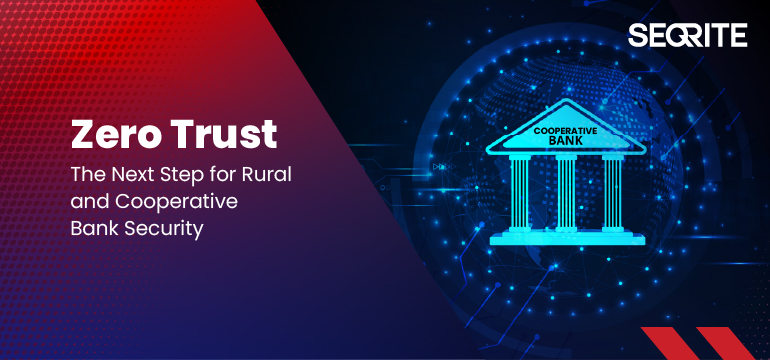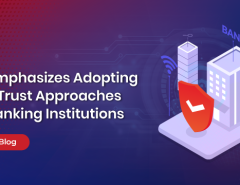India’s banking ecosystem has witnessed remarkable digital progress in recent years, with rural and cooperative banks playing a pivotal role in this transformation. From Aadhaar-enabled payments to mobile banking, these institutions have played a crucial role in bringing financial inclusion to the most remote corners of the country.
But with digitization comes risk. The same technologies that have made rural banking convenient and accessible have also opened new avenues for cyberattacks. As threat actors increasingly target smaller, less fortified financial institutions, it’s clear that traditional perimeter-based security is no longer enough. The time has come for rural and cooperative banks to embrace a new security paradigm, Zero Trust Network Acess.
The Growing Cyber Threat Landscape for Rural and Cooperative Banks
Cybercriminals have realized that smaller banks often serve as “soft targets.” They handle sensitive financial data, usually rely on legacy systems, and may lack the advanced security infrastructure of large commercial banks. Ransomware, phishing, credential theft, and insider threats are now common occurrences across the financial sector — and rural banks are no exception.
A 2024 report by CERT-In indicated a sharp rise in cyberattacks targeting smaller financial entities, many of which were attributed to outdated systems and weak access control policies. Attackers no longer need to breach the central systems of a large bank when smaller, interconnected institutions provide easier entry points into the same financial ecosystem.
Why Traditional Security Is No Longer Enough
For years, banks have relied on a “castle-and-moat” security model — where everything inside the network was trusted, and the focus was on keeping threats out. But today’s banking networks are dynamic and borderless. Employees work remotely, vendors access core systems, and customers transact through multiple digital channels.
Once an attacker slips past the “moat,” they often have unrestricted access to sensitive data and systems. This makes lateral movement — the ability to move within the network after gaining initial access — a serious risk.
Clearly, trust based solely on network location or user credentials is no longer a safe bet.
Zero Trust: “Never Trust, Always Verify”
Zero Trust is a modern cybersecurity approach built on a simple yet powerful principle: trust nothing and verify everything. Instead of assuming that users or devices inside the network are safe, Zero Trust enforces continuous verification at every step — regardless of where the connection originates.
Key principles of Zero Trust include:
- Continuous Authentication and Authorization: Every user and device must prove its identity and security posture before gaining access.
- Least Privilege Access: Users are granted only the minimum access necessary to perform their roles, reducing the potential impact of compromised credentials.
- Micro-Segmentation: The network is divided into smaller zones to contain breaches and prevent lateral movement.
- Visibility and Analytics: Continuous monitoring and behavioral analysis help detect anomalies and potential threats in real time.
Why Zero Trust Fits Perfectly for Rural and Cooperative Banks
For rural and cooperative banks, Zero Trust provides a practical framework that strikes a balance between security and operational simplicity. Here’s why:
- Protection Against Insider and Credential-Based Attacks:
Many security breaches originate from compromised employee credentials or insider misuse. Zero Trust minimizes this risk by enforcing identity-based access and continuous verification. - Securing Third-Party Access:
Cooperative banks often depend on external vendors or service providers for IT support, payments, or core banking systems. Zero Trust ensures that external entities only access what they’re authorized to, and nothing more. - Safeguarding Legacy Systems:
Many smaller banks operate on legacy infrastructure that cannot be easily replaced. Zero Trust can be integrated with existing systems to provide layered protection without requiring a complete overhaul. - Enhanced Regulatory Compliance:
As India tightens data protection and cybersecurity regulations, adopting a Zero Trust framework helps banks align with compliance requirements such as RBI’s cybersecurity guidelines and the DPDP Act. - Improved Incident Response and Visibility:
With granular access controls and continuous monitoring, IT teams can quickly detect, isolate, and respond to threats — reducing downtime and data exposure.
Implementing Zero Trust: A Practical Roadmap for Cooperative Banks
While Zero Trust may sound complex, its adoption can be phased and strategic:
- Assess the Current Security Posture:
Begin by mapping critical assets, user roles, and existing vulnerabilities. - Adopt Strong Identity and Access Management (IAM):
Enforce multifactor authentication (MFA), single sign-on (SSO), and role-based access control (RBAC). - Segment the Network:
Create smaller, isolated zones to limit the blast radius of any potential breach. - Implement Continuous Monitoring:
Deploy tools that provide visibility into user behavior, endpoint activity, and data flows. - Automate Policy Enforcement:
Use security orchestration and automation tools to ensure policies are consistently applied and updated. - Educate and Empower Users:
Regular awareness training ensures employees understand security best practices and Zero Trust principles.
Conclusion: The Road Ahead
As India’s financial inclusion efforts continue, rural and cooperative banks will remain critical to the nation’s economic growth. However, this growth must be protected by resilient cybersecurity strategies. Zero Trust provides a scalable, adaptable model that helps these banks stay secure in an increasingly connected and hostile digital environment.
By adopting Zero Trust, cooperative and rural banks can not only safeguard their data but also strengthen customer trust — ensuring that digital progress never comes at the cost of security.
Seqrite: Enabling Zero Trust for India’s Banking Future
At Seqrite, we understand the unique security challenges faced by India’s rural and cooperative banks. Seqrite Zero Trust Network Access (ZTNA) solution empowers institutions to verify every connection, secure every endpoint, and protect every transaction — all while maintaining operational efficiency and compliance. Experience the power of Zero Trust with Seqrite.




